My Annual Waste Jar, Deconstructed (+ Lessons Learned)
For the last 12 months, I saved all* of my landfill waste in a jar. I talked last week about why I felt like it was a bit gimmicky but did it anyway; the purpose behind keeping our waste in a jar, the reasons I liked doing it, and the reasons I did not like doing it.
*I also talked about why ‘all’ didn’t actually mean all. I shared a picture of the contents of my jar.
But I didn’t actually talk about what was in the jar.
You know me, I love talking about rubbish. Give me any excuse ;) I thought I’d explore what was in my jar with you, and what I learned from the experience of collecting my rubbish. If you have any questions or would like to share any wisdom, I’d love to hear at the end!
Contents of a Zero Waster’s Annual Rubbish Jar:
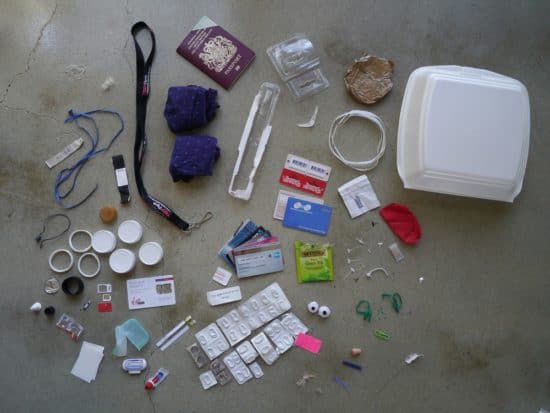
The entire contents of my jar (plus my passport and that scandalous polystyrene container, which didn’t fit.) I’ve divided up the picture into 4 to talk about each segment separately.
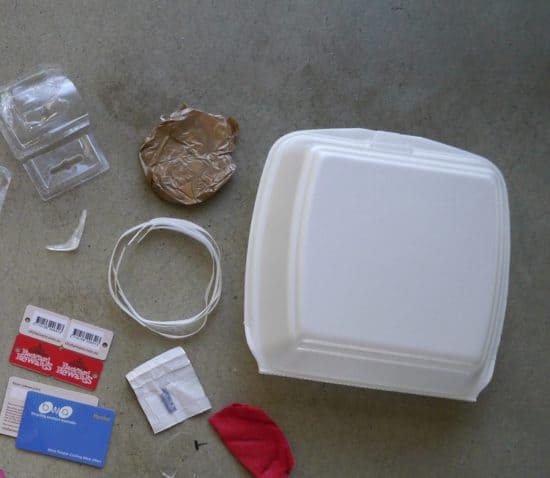
Polystyrene container: After 5 years of plastic-free living, I end up with a polystyrene container! Shortly after we moved we went to a nearby pizza place. I took a container with me for leftovers but the pizzas were bigger than expected, and didn’t fit. The waiter asked if I wanted a box, and as they are usually cardboard, I said yes. Imagine my horror when I was handed a polystyrene box! Needless to say, we will never go back!
A local place recycles polystyrene, but I’m not sure if it is just the expanded stuff. I intend to go there with my container and find out more. (It’s called CLAW Environmental.)
Lesson learned: Never assume, because you are never too experienced to get caught out unawares!
Brown Packing Tape: This could be polypropylene (plastic #5), the same as sellotape/sticky tape, but I’m not sure so I kept it in my jar. If it is, it can be recycled through REDcycle (who collect soft plastic for recycling via supermarkets in Australia). I recycle any sticky tape I get this way.
Lesson Learned: Recycling is complicated, and it isn’t always obvious what material something is made from. Refusing is always the best option, if possible!
Plastic packet: We needed to buy a specialty light bulb for a common-shared outdoor light. We purchased the bulb, so it counts as waste in my eyes.
Lesson Learned: Some plastic just cannot be avoided.
Plastic chip from our soap dish: Our shower has a plastic soap dish attached (it came with the house), and my husband seems to constantly knock it off. Plastic can only be dropped so many times before it shatters! The rest of the dish is intact, it is just missing a corner.
Lesson Learned: Next time, choose a material that lasts and can be recycled or composted at the end of its life.
Cable from our garden hose: We bought a new hose to water our veggie patch. The hose was attached to a cardboard label via this cable. (It is possible that CLAW Environmental also recycle this type of plastic, so I will check.)
Lesson Learned: If you buy new, there is almost always packaging.
Loyalty and Membership Cards: One is a loyalty scheme we joined by mistake. We thought we wouldn’t get a card, but the sales lady meant you don’t need to show the card to get the discount (they can look our names up). Two key fob ones too, lucky us. The other card is an unnecessary membership card for a bicycle organisation.
Lesson Learned: Loyalty might be rewarded, but the environment is not.
Courgette seed packet: This pack is a combination of paper, foil, and maybe plastic. Some seeds come loose in paper packets, some in plastic zip lock bags (which can be repurposed) and some like this. In the future I plan to save my own seeds, but I needed seeds to start with!
Lesson learned: Sometimes activities create waste in the beginning, but help reduce waste long-term.
Red elastic bandage: Our greyhound went to the vet for an x-ray and we picked him up sporting this bandage. I have no idea what it is made from, but I am almost certain it isn’t recyclable.
Lesson learned: Sometimes plastic is a medical necessity.
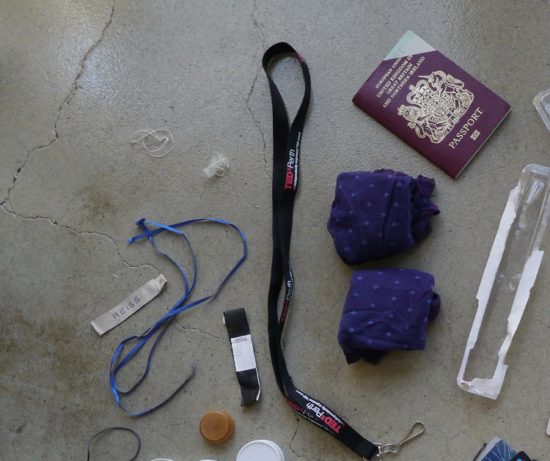
Plastic packet: After 5 years of living plastic-free and my promising to label our pantry jars, my husband finally had enough and purchased two grease pencils to label them himself! They came in this pack.
Lesson learned: Everyone has a limit to their patience ;) Sometimes a little waste is worth it to keep the peace.
Passport: My passport expired. I sent it back to the UK Passport Authority. They sent me my new passport but also returned my old one. It arrived on day 364 of my year. Thanks guys – now I have to add it to my waste jar!
Lesson Learned: At least it is only once every 10 years…
Underpants: I prefer plain, sensible underpants. But for some reason in my late twenties I decided I should give fancy underpants a go. Fortunately the phase didn’t last. These aren’t cotton and so won’t compost.
Lesson learned: Choose fabrics that can biodegrade.
Tedx Lanyard: The lanyard strap from my Tedx Perth talk (I composted the cardboard part) which I needed to access the venue. It is a shame that they couldn’t collect them for reuse, as all 1700 people had one! I will separate the metal clip for recycling. (My husband kept his as a souvenir!)
Lesson Learned: Sometimes the system creates waste, and if we really want a zero waste society, we need to work to change the system.
Dental floss: Used for emergencies. I have used more than two pieces but they were gobbled up by the vacuum cleaner. When this (pre-2011) roll runs out I will choose biodegradable floss.
Lesson learned: Think about the end of a product when choosing something new, and stay alert for better options.
Jumper label and hanging ribbons: I used non-biodegradable old clothes to stuff a bed for our greyhound, but this jumper was wool so I composted it. These bits aren’t compostable so they ended up in the jar.
Lesson learned: 100% cotton/wool/silk/hemp doesn’t necessarily mean 100% biodegradable.
Black wristband: from the Tedx post-event wrap-up celebration. I assume it was issued by the venue.
Lesson learned: Plastic can be found in the most unexpected places, but we can write to companies/businesses/venues to share our concerns and suggest alternatives.
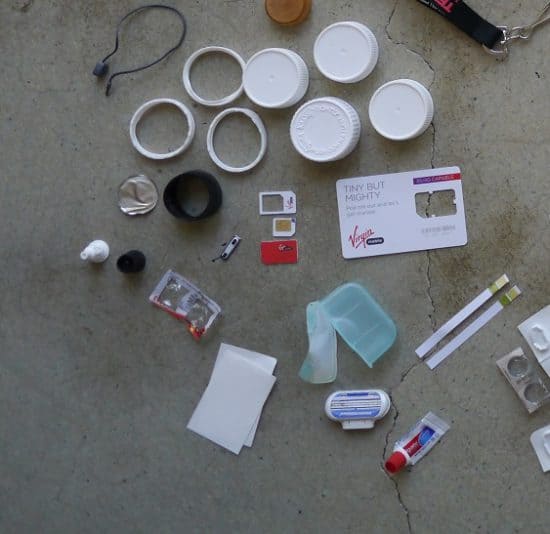
Plastic bottle caps: Mostly from medicine bottles; the orange one is from a whisky bottle and the black one from an oil bottle I used to refill.
Lesson learned: plastic lids are not recyclable in Western Australia, so avoiding them is always best or they will end up in landfill.
Blister pack from two coin batteries: The old ones had run out.
Lesson learned: The less batteries we use, the less waste there is.
Sticker backing: The first thing to go in my jar! Possibly recyclable via REDcycle but I wasn’t sure of the material. It was the backing for our “no junk mail sticker”.
Lesson learned: Sometimes we need to create waste now to reduce waste in the future.
Razor blade and packet: I still use a plastic razor with blades I purchased pre-2011 (I talked about why here). With careful looking after, each blade lasted me a year. I am now down to my last.
Lesson learned: With care, we can prolong the life of things deemed “single use” or “disposable”.
Sim card: My phone died in March last year and the replacement needed a nano sim rather than the micro sim that I already had. So I had to replace the whole lot.
Lesson learned: Sometimes planned obsolescence is unavoidable.
pH strips: I thought these were paper, but after putting them in the worm farm discovered they are plastic.
Lesson learned: Looks can be deceiving.
Tiny toothpaste tube: I found this, still sealed, when picking up litter in a park. I figured it was less wasteful to use it. Terracycle recycle toothpaste tubes so I will drop off at one of their collection points.

Bank cards: I have English cards and Australian cards, and they all expired last year! We changed banks when we got our mortgage, so that was an extra set of cards in the jar.
Lesson learned: If I simplify my banking there will be less plastic and waste.
Tea bag wrapper: This can be recycled via REDcycle. It is a combination of foil and plastic but I mistakenly thought it was paper. It was from a workshop I attended.
Lesson learned: sometimes we make mistakes. The fact this should actually be in the recycling bin and not the jar is a mistake. I wonder, what did I mistakenly put in the recycling?
Medicine packets: My husband and I both got the flu last year, and took almost all of these in that week. We try to avoid medicine except for emergencies. This was an emergency.
Lesson learned: In medical emergencies, our health is a priority.
Plastic tags: I’ve purchased a few second-hand items from charity shops, and they all come with little plastic tags.
Lesson learned: Second-hand keeps waste to a minimum, but doesn’t eliminate it altogether.
Googly eyes: These are from a toy my in-laws purchased for our greyhound. Mister Duck’s feet got gnawed off too but those went in the bin. I debated whether Hans’ waste (which I have no control over) should go in the jar or not, so I compromised. (Plus the feet were absolutely covered in slobber.)
Lesson learned: it isn’t always possible to avoid all the waste that all our family members create, and sometimes there needs to be a little compassion and compromise.
Green twisty tags: I have no idea where these came from. I have noticed that they have already started to degrade in the jar.
Lesson learned: plastic often isn’t fit for purpose.
Pink tape: Ironically, from a waste reduction behaviour change campaign I worked on. We used pink gaffa tape in the project. At the end we received thank-you cards sealed with this tape.
Lesson learned: Novelty gestures almost always result in waste.
Miscellaneous bits: The clip on a pen lid; an elastic band tangled in some (non-biodegradable) fabric; a plastic toggle from a pair of shorts (the other one is already lost); melted plastic from a Pyrex lid I put too near a hot saucepan; and a paperclip that isn’t plastic.
Lesson learned: If there is any plastic anywhere in the home, it is likely that at some stage it will end up in landfill. Where there is an alternative, seek it out!
Overall, I enjoyed the experience of collecting my waste in a jar, and I learned a lot. Will I continue this year? I’m not sure. My passion is community, and I’d rather spend my time and energy helping others reduce their waste than fixate over a piece of dental floss or a plastic blister pack.
Personal change is great. But building a movement? That’s much better.
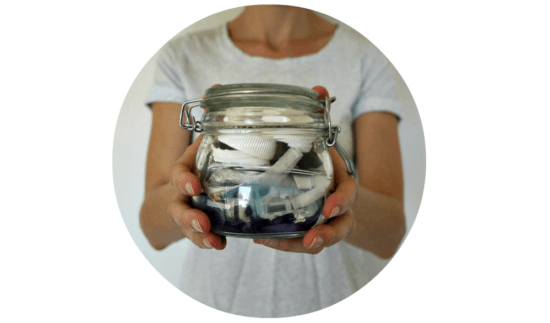
Now I’d love to hear from you! Tell me – would you find it helpful if I continued to keep an annual waste jar? Is it something that you’d like to see again next year? Was there anything in my waste jar that surprised you? Was there anything that you expected to see in there that wasn’t there? Do you have any suggestions for how to dispose of any of the items currently in the jar? Do you have any other thoughts about my waste, or waste jars in general? Anything else you’d like to add? Please tell me your thoughts in the comments below!
[leadpages_leadbox leadbox_id=1429a0746639c5] [/leadpages_leadbox]
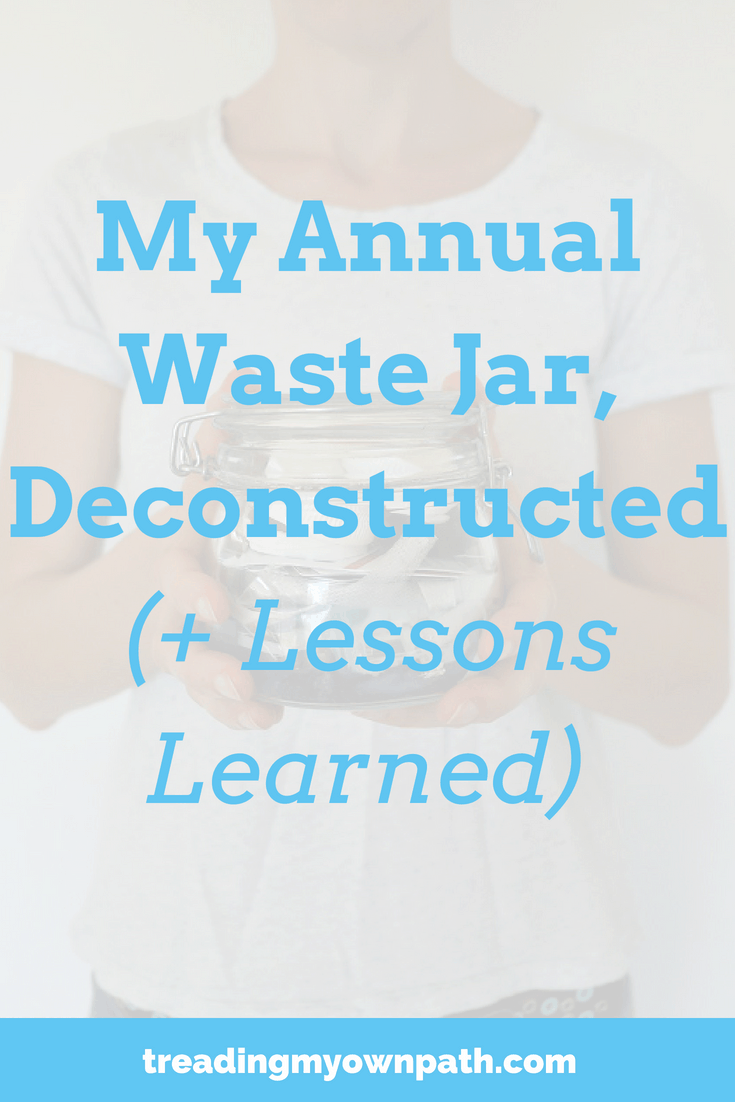

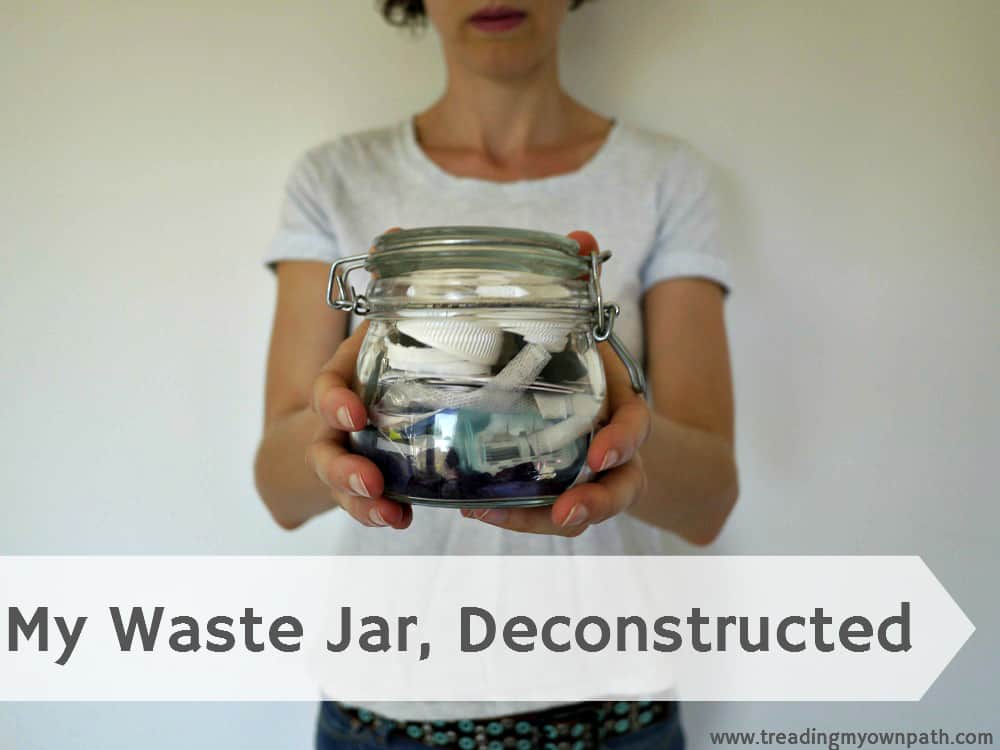

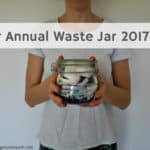


I’m not big on the trash jar thing. It isn’t actually all the waste one creates in a year. I tried doing it but it just wasn’t feasible for me. It’s surprisingly time consuming to keep trash in a jar. I don’t know why but it is. I also had a hard time deciding what “counts.” Just my trash? My family’s trash too? Like if I ate the banana with no sticker and left the one with a sticker for my husband. That’s a bit deceiving in terms of how much trash (if I kept just my own). And what if I’m part of some trash but it’s mostly someone else’s?
I think it was a good experiment and I’m glad you shared the story! But I don’t think it’s necessary to be a ZW advocate. :)
Hi Stargirl and thanks for your comment! I am definitely an overthinker, and I totally agree about the “deciding what counts” factor. At the start I assumed it was all of us, but then a few months later my husband questioned why I was putting some empty blister packs in the jar as they were his waste, not mine. So I realised he probably has waste at work etc that doesn’t go in the jar. Then we got the dog and it was even more confusing!
And I also feel like I need to explain all of this any time someone sees or hears about the jar!
I’m glad I’ve done it, but I’m not sure I’ll continue for another year…
I look forward to your new blog posts so much. I read them all but don’t often comment, mainly because I hate writing. We are able to send any unusable fabric items to the charity shops here so that the “scrap man” will buy them. They are then shredded & made into things like packing blankets. I sew a lot so keep a basket near by to put all tiny fabric offcuts & thread clippings into. When I have a bag full I drop it at the charity shop & just let them know it is fabric scraps before they tip it out for sorting. Your underwear, label, lanyard & hanging ribbons would all be accepted for this.
Thank you for all your inspiration, you have no idea what an impact it has had on me.
Aw thank you! Well it is very nice and much appreciated that you have taken the time to comment today :) Scrap cloth recycling isn’t as common here as it is in the UK, and charity shops don’t take scraps all the time. Even when they do, I really wasn’t sure they’ want used underpants ;p
We have an H & M opening in Perth CBD soon I saw, and they run a clothes recycling scheme. I like the idea of taking it there, as I think that a company that is responsble for encouraging fast fashion and the resulting waste should be responsible for dealing with it too. I’ll have to find out the rules once they open…
Thank you so much for your kind words! Enjoy your weekend x
Thanks for sharing your Lessons Learned. ZW is full of lessons, and some uphill battles…
Oh it so is, Rebekah! And yes, battles too. Hope you found it useful though!
I enjoyed reading about your waste in your jar! It was fun and educational: it made me think! I cannot imagine succeeding in reducing my landfill to just one jar, but I am certainly going to try!
Thank you….
Thanks Ralph! Glad you found it useful. Remember I have been working on reducing my waste since 2012, so this is after 4 years of mastery ;) It is good to track your progress and see room for improvement though, whatever size vessel you use!
Great post! I am trying a similar thing, keeping all my non-recyclable or compostable waste in a box for a month to see how much I really make. I try to be plastic free and have as minimal waste as possible but some things are unavoidable :/ every bit of waste avoided is a positive though.
Hi Kai’a, thank you for your comment! I couldn’t agree more, whatever we can do is all adding up to create a huger difference :) And yes, some things are unavoidable. Where we live and our lifestyle needs also vary across the world. We can only do what we can do! :)
Every tried giving up shaving to create less waste? The same with not having daily showers, I have grabbed back a bunch of time and found it makes no difference to my life. I used to shave because I thought it kept my body cooler in summer. Now I’ve been a few years without I see that it didn’t matter!
Hi Sarah, thanks for these thoughts! I don’t need to shave often, I have very fair hair on my legs and if I’m wearing trousers, I don’t bother. That said, if I’m wearing a skirt I prefer to shave my legs. Personal preference.
As I predominantly work from home, if I’m not leaving the house, then I might skip a shower. I’m from the UK and growing up, we didn’t even have a shower, only a bath, so I never got into the habit of daily showers.
Thanks for sharing, I think you do a good job of balancing ‘this is how little waste I created’ with education. I understand how conflicted you are in this, perhaps because there is good and bad aspects around this sharing. For my part, it’s good to talk about the learnings (and to see that painkiller packaging stumps you too!) I can see value in repeating this, but maybe every five years rather than annually? It might be interesting to see the development of your own approach as well as any changes in the disposal services you have access to
Thanks Rachel! Ah, painkiller packaging! There is a brand that sells tablets in a plastic pot rather than blister packs. But there’s a few downsides: the lid (plastic) isn’t recyclable, there is more plastic overall, and the tablets are blue! I do not trust anything synthetic and blue!
I like the idea of every few years. I’m not sure I want to do it again this year. I find having the jar in my home a burden (see what a minimalist I’ve become! ;)
Bahaha, made me laugh: “I do not trust anything synthetic and blue” is this a quirk (in which case, cool), or is this a real thing? (in which case, please elaborate)..
Absolutely love your posts!! Just wanted to mention that the plastic lids can now be recycled in the South Australian recycling program (just have to collect them in a detergent bottle or something similar) – something i didn’t even realise myself! So thanks to your post, i straight away looked it up for my state. Maybe if you just slightly change the wording to outline that it’s not recycled in your state but others it is, it might encourage more people to double check. Just a suggestion:)
Thanks Taylor, and thanks for your nugget of info! That’s great news for you :) I’ve updated my post to reflect Western Australian rather than country-wide. Recycling info changes so fast, and across every country/state/city, it is very hard to keep up!
impressive; gives one ideas on how to reduce etc am puzzled about the teabag wrapper – I’ve put acouple in the bin — oops! no longer buy it, but gotta use it up !
Hi Geraldine! Sometimes they are paper, and that can obviously be recycled. A single plastic/foil teabag like this is too small to get processed if it goes in loose (assuming you can put that kind of plastic in your recycling). In WA, REDcycle take this type of plastic for recycling. Yes, I no longer buy tea bags now – loose leaf for me! :)
CAPS!! Although they will still end up in landfill eventually, I can take plastic caps of all types to my local preschool or kindy. They do all sorts of creative activities with them. Now… you have prompted me to work on not having caps I need to get rid of! You’re a national treasure, Lindsay!
Caps indeed Bev! There is a plastics recycling place here that will take them, but to drive there to drop off a few caps is a bit of a waste of fossil fuels. Better to find things that don’t have caps! ;)